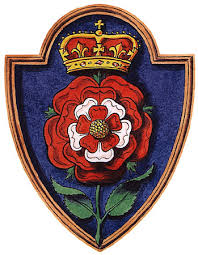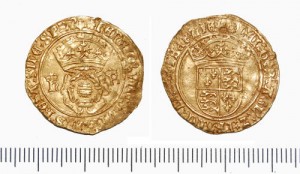
Thank you to Lauryn Poe for inspiring this post and to Conor Byrne, Marilyn Roberts and Judith Loriente for the subsequent discussions on this issue.
Lauryn contacted me last month to ask me whether I knew of a primary source for Henry VIII referring to Katherine Howard as his “rose without a thorn”. I was already researching Katherine myself and hadn’t come across a source during my research, just historians saying that Henry referred to her as such. I decided to do some digging into it as that’s what I like best, a mystery, something to get to the bottom of.
I consulted the secondary sources on my bookshelf. In The Six Wives of Henry VIII, Alison Weir wrote that “Henry was so besotted with Katherine that he ordered a medal to be struck in commemoration of their marriage. It was of gold, embossed with Tudor roses and true lovers’ knots entwined, and it carried the inscription: HENRICUS VIII: RUTILANS ROSA SINE SPINA, a pretty reference to the King’s rose without a thorn, his perfect bride”,1 but there was no reference cited. Fortunately, I had better luck with Antonia Fraser’s The Six Wives of Henry VIII. In her book, Fraser wrote that “To Henry VIII, Katherine Howard was his ‘blushing rose without a thorn’.” and in her notes she gave the Latin motto, RUTILANS ROSA SINE SPINA (blushing rose without a thorn) and cited Agnes Strickland, the Victorian historian, as her source.2 I have Strickland’s The Lives of the Queens of England: Volume II so I checked and Strickland wrote:
“He could neither afford to honour Katherine Howard with a public bridal nor a coronation, but he paid her the compliment of causing gold coins to be struck in commemoration of their marriage, bearing the royal arms of England, flanked with H R, and surmounted with the royal diadem. On the reverse is a rose, crowned, in allusion to his bride, flanked by the initiala K R, with the following legend:- HENRICUS VIII. RUTILANS ROSA SINE SPINA.”3
Strickland did not give any more details on the coin struck for Katherine so I then went digging into Tudor coins. In Dye’s Coin Encylopaedia, I found that Henry VIII “introduced the ‘Gold Crown’ into the English series of coinage” and that this coin had “upon its obverse a double rose, crowned between the letters ‘H.R.’ (Henry Rex). ‘H.A.’ (Henry and Anne). ‘H.J.’ (Henry and Jane). ‘H.K.’ (Henry and Katherine)”. It bore the legend “HENRIC. VIII. RUTILANS ROSA SIE SPIA”, or Henricus VIII., Rutilans rosa sine spina, meaning “Henry VIII, the shining/dazzling rose without a thorn. So, this encyclopaedia was stating that the legend actually described Henry, not Katherine.4
I then consulted other coin books and websites. In Coins of England and Great Britain, Tony Clayton stated that the “Crown of the Rose” coin was “an extremely rare coin struck during the second coinage of Henry VIII for a few months in 1526” and explained that there were “two types, both of which feature a large rose on the reverse. One has the inscription HENRIC RUTILANS ROSA SINE SPINA, meaning ‘Henry a dazzling rose without a thorn’, and the other DNS HIB RUTILANS ROSA SINE SPINA, meaning ‘Lord of Ireland a dazzling rose without a thorn’.”5 Henry VIII was still married to Katherine of Aragon in 1526 so this coin was not a medal struck in celebration of his marriage to Katherine Howard. Thomas Snelling’s A View of the Silver Coin and Coinage of England from the Norman Conquest gave exactly the same information as Dye’s Coin Encylopaedia.6 In Henfrey’s Guide to English Coins, it said:
“Crown. Obv. a double rose crowned, between the letters H.K. (for Henry, and Katherine his 1st wife); or H.A. (for Henry, and Anne his 2nd wife); or H.I. (for Henry, and Jane his 3rd wife); or the letters H.R. (for Henricus Rex). All these letters are crowned. HENRIC VIII. RVTILANS ROSA SIE SPIA.”7
It also described the half-crown as being similar but with uncrowned letters next to the legend.
On the Portable Antiquities Scheme website, which records archaeological finds, I found a photo of a gold crown from Henry VIII’s reign which was dated 1509-1526 and bore a crowned H and R with the legend “HENRIC VIII RUTILANS ROSA SINE SPINA”.8 On /www.coinandbullionpages.com, there are photographs of each side of “the Crown of the Double Rose” which has the crowned initials H and I (I was for Jane) either side of the Tudor rose on one side and Henry VIII’s arms on the other. It also bears the legend HENRIC VIII. RVTILANS ROSA SIE SPIA, which is proof that the legend was being used before Henry had even met Katherine Howard.

When I spoke to Conor Byrne, author of Katherine Howard: A New History, about my doubts over the coin being struck for Katherine Howard he pointed out that David Starkey had pointed this out in his book on the six wives – “why hadn’t I looked at that book first?”, I asked myself. In his notes on his chapter on Katherine. Starkey writes that the motto “originates with Agnes Strickland” and that the coin in question, the Crown of the Double Rose, “had been issued since Wolsey’s recoinage of 1536.”9 He went on to explain that after Jane Seymour’s death the coin bore the cipher “HR” and remained that way from 1537 until the end of Henry’s reign. He also stated, as I’d found out, that the motto/legend referred to Henry. Starkey concluded that the rose badge and motto had nothing to do with Katherine and that “this reading of the evidence is confirmed by M. Siddons, Heraldic Badges of England and Wales. Dr Siddons finds that Catherine, unlike Henry’s other wives, seems to have displayed no personal badge.” That would explain why the only image of Katherine’s rose badge I’ve been able to find is the one from the Weidenfeld & Nicolson archive (a publisher established in 1948). I have not been able to find any mention of Katherine’s “rose” badge in any primary sources or any images of it from any historic houses. The badges or “arms” Antonia Fraser writes of being inserted by Galyon Hone, the King’s glazier, at Rochester, and quickly removed in 1542 after Katherine’s fall, may well have been a cipher like the “HA” ciphers (Henry and Anne) that Henry tried to get removed from Hampton Court Palace after Anne Boleyn’s fall.10 If anyone knows of any badges depicting a rose for Katherine then please do share in the comments below.
David Starkey writes of how Agnes Strickland’s “rose without a thorn” story “has been repeated, with less excuse, by her many successors” and it’s true. I am one of those “successors”, I have been guilty of writing of Henry VIII referring to Katherine as his “rose without a thorn” and also “a perfect jewel of womanhood”,11 which were actually his privy council’s words and not his own. Henry VIII may well have believed Katherine to be unblemished and perfect, but the romantic motto and badge seem to be fiction. What a shame!
So, we go from Katherine being Henry VIII’s “blushing rose without a thorn” to Henry VIII being the “dazzling rose without a thorn”, interesting…
You can read more about Katherine Howard in Conor Byrne’s new biography Katherine Howard: A New History.
Coin image – Gold crown of Henry VIII, Bristol City Council, from finds.org.uk/database/images/image/id/334156 and used under Creative Commons licence.
Notes and Sources
- Weir, Alison (2007) The Six Wives of Henry VIII, p436
- Fraser, Antonia (1992) The Six Wives of Henry VIII, p405,548
- Strickland, Agnes (1866) Lives of the Queens of England, Volume II, p351-2
- Dye, John S (1883) Dye’s coin encyclopædia: a complete illustrated history of the coins of the world, p771
- Clayton, Tony (2013) Coins of England and Great Britain (‘Coins of the UK’) – see http://www.coins-of-the-uk.co.uk/fours.html
- Snelling, Thomas (1762) A View of the Silver Coin and Coinage of England, from the Norman Conquest to the Present Time, p12
- Henfrey’s Guide to English Coins (A Guide to the Study and Arrangement of English Coins by Henry William Henfrey) (1870), p38
- Portable Antiquities Scheme – see http://finds.org.uk/database/artefacts/record/id/449941
- Starkey, David (2003) The Six Wives of Henry VIII, p810 (note 17 to chapter 73)
- Fraser, p437
- LP xvi 1334, 12 November 1541, The Council to Paget, Ambassador in France: “The King, on sentence given of the [invalidity] of his marriage with Anne of Cleves, being solicited by his Council to marry again, took to wife Katharine, daughter to the late lord Edmund Howard, thinking [now in his old] age to have obtained [a jewel] for womanhood.”